Xerox 3117 User Manual
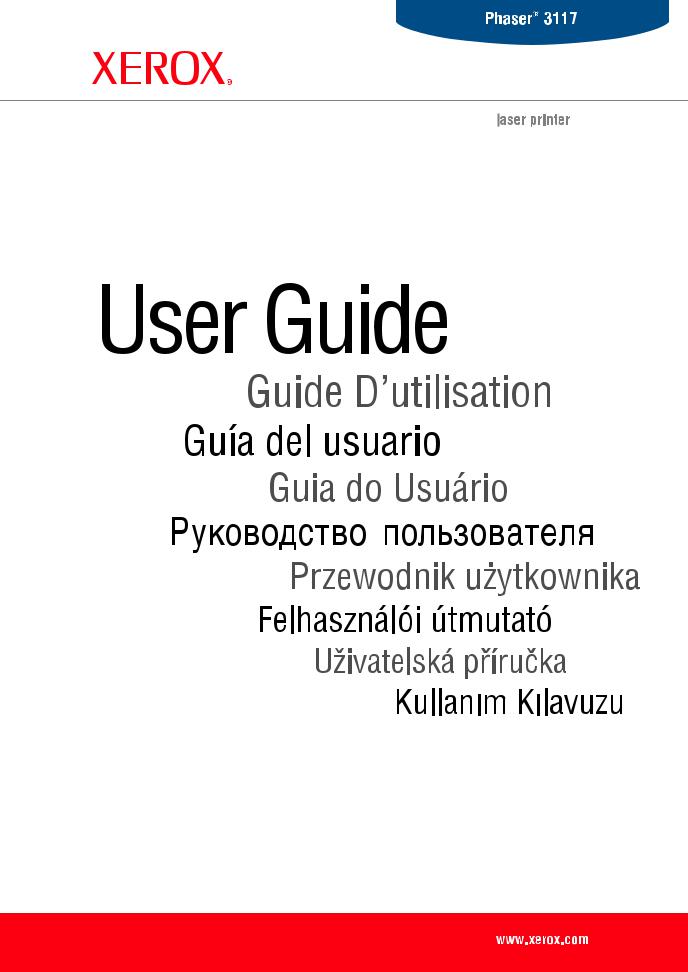

About the User Guide
This User Guide provides information you need for setting up your printer.
It also provides all of the detailed instructions for using your printer and information for maintaining and troubleshooting the printer.
The Software User Guide which is the second section of this guide provides information you need for installing the supplied software and using its features.
This manual is provided for information purposes only. All information included herein is subject to change without notice. Xerox Corporation is not responsible for any damages, direct or indirect, arising from or related to use of this manual.
© 2005 Xerox Corporation. All rights reserved.
•Phaser 3117 is model name of Xerox Corporation.
•Xerox logo are trademarks of Xerox Corporation.
•Centronics is a trademark of Centronics Data Computer Corporation.
•IBM and IBM PC are trademarks of International Business Machines Corporation.
•Microsoft, Windows, Windows 98, Windows Me, Windows 2000 and Windows XP are registered trademarks of Microsoft Corporation.
•All other brand or product names are trademarks of their respective companies or organizations.
1

CONTENTS
Chapter 1: INTRODUCTION
Special Features .................................................. |
1.2 |
Printer Driver Features ......................................... |
1.3 |
Printer Components ............................................. |
1.4 |
Understanding the Control Panel ............................ |
1.6 |
On Line/Error() and Toner Save() LEDs .............. |
1.6 |
Cancel() button .............................................. |
1.7 |
Chapter 2: SETTING UP YOUR PRINTER
Unpacking .......................................................... |
2.2 |
Selecting a Location ........................................ |
2.3 |
Installing the Toner Cartridge ................................ |
2.4 |
Loading Paper ..................................................... |
2.7 |
Connecting a Printer Cable .................................... |
2.9 |
Turning the Printer on ......................................... |
2.10 |
Printing a Demo Page .......................................... |
2.11 |
Installing Printer Software ................................... |
2.12 |
Chapter 3: USING PRINT MATERIALS
Choosing Paper and Other Materials ....................... |
3.2 |
Type and Capacities ...................................... |
3.3 |
Guidelines for Paper and Special Materials .......... |
3.3 |
Verifying the Output Location ................................ |
3.6 |
Loading Paper ..................................................... |
3.6 |
Using the Tray ................................................ |
3.6 |
Using Manual Feed Mode ................................. |
3.7 |
Printing on Special Materials ................................. |
3.8 |
Canceling a Print Job ........................................... |
3.10 |
Chapter 4: MAINTAINING YOUR PRINTER
2

Maintaining the Toner Cartridge ............................. |
4.2 |
Redistributing Toner ........................................ |
4.3 |
Replacing the Toner Cartridge .......................... |
4.5 |
Using the Toner Save Mode ................................... |
4.5 |
Cleaning the Printer ............................................. |
4.6 |
Cleaning the Outside ....................................... |
4.6 |
Cleaning the Inside ......................................... |
4.6 |
Consumables and Replacement Parts ..................... |
4.9 |
Chapter 5: SOLVING PROBLEMS
Troubleshooting Checklist ..................................... |
5.2 |
Solving General Printing Problems .......................... |
5.3 |
Clearing Paper Jams ............................................. |
5.6 |
In the Paper Exit Area ..................................... |
5.7 |
In the Paper Feed Area .................................... |
5.9 |
Around the Toner Cartridge .............................. |
5.9 |
Tips for Avoiding Paper Jams ........................... |
5.11 |
Solving Print Quality Problems .............................. |
5.11 |
Print Quality Checklist .................................... |
5.11 |
Solving Print Quality Problems ......................... |
5.12 |
Troubleshooting Error Messages ........................... |
5.17 |
Common Windows Problems ................................ |
5.18 |
Common Linux Problems .................................... |
5.19 |
Chapter 6: SPECIFICATIONS
Printer Specifications ............................................ |
6.2 |
Paper Specifications ............................................. |
6.3 |
Overview ....................................................... |
6.3 |
Supported Sizes of Paper ................................. |
6.4 |
Guidelines for Using Paper ............................... |
6.5 |
Paper Specifications ........................................ |
6.6 |
Paper Output Capacity ..................................... |
6.6 |
Printer and Paper Storage Environment ............. |
6.7 |
3

Important Precautions and Safety Information
When using this machine, these basic safety precautions should always be followed to reduce risk of fire, electric shock, and injury to people:
1Read and understand all instructions.
2Use common sense whenever operating electrical appliances.
3Follow all warnings and instructions marked on the machine and in the literature accompanying the machine.
4If an operating instruction appears to conflict with safety information, heed the safety information. You may have misunderstood the operating instruction. If you cannot resolve the conflict, contact your sales or service representative for assistance.
5Unplug the machine from the AC wall socket before cleaning. Do not use liquid or aerosol cleaners. Use only a damp cloth for cleaning.
6Do not place the machine on an unstable cart, stand or table. It may fall, causing serious damage.
7Your machine should never be placed on, near or over a radiator, heater, air conditioner or ventilation duct.
8Do not allow anything to rest on the power cable. Do not locate your machine where the cords will be abused by persons walking on them.
9Do not overload wall outlets and extension cords. This can diminish performance, and may result in the risk of fire or electric shock.
10Do not allow pets to chew on the AC power or PC interface cords.
11Never push objects of any kind into the machine through case or cabinet openings. They may touch dangerous voltage points, creating a risk of fire or shock. Never spill liquid of any kind onto or into the machine.
12To reduce the risk of electric shock, do not disassemble the machine. Take it to a qualified service technician when repair work is required. Opening or removing covers may expose you to dangerous voltages or other risks. Incorrect reassembly could cause electric shock when the unit is subsequently used.
4

13Unplug the machine from the PC and AC wall outlet, and refer servicing to qualified service personnel under the following conditions:
•When any part of the power cord, plug, or connecting cable is damaged or frayed.
•If liquid has been spilled into the machine.
•If the machine has been exposed to rain or water.
•If the machine does not operate properly after instructions have been followed. •If the machine has been dropped, or the cabinet appears damaged.
•If the machine exhibits a sudden and distinct change in performance.
14Adjust only those controls covered by the operating instructions. Improper adjustment of other controls may result in damage, and may require extensive work by a qualified service technician to restore the machine to normal operation.
15Avoid using this machine during a lightning storm. There may be a remote risk of electric shock from lightning. If possible, unplug the AC power for the duration of the lightning storm.
16If you continuously print multiple pages, the surface of the output tray may become hot. Be careful not to touch the surface, and keep children away from the surface.
17SAVE THESE INSTRUCTIONS.
5
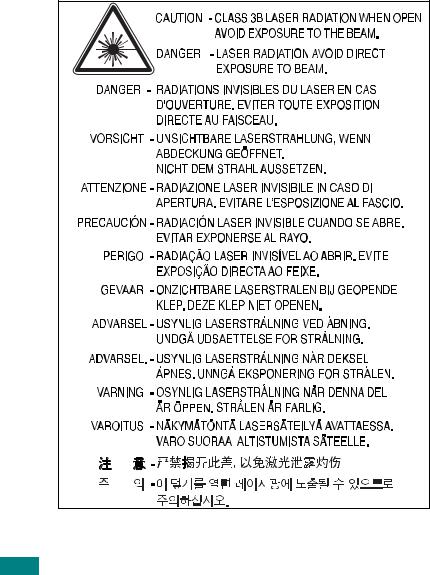
Environmental and Safety Consideration
Laser Safety Statement
The printer is certified in the U.S. to conform to the requirements of DHHS 21 CFR, chapter 1 Subchapter J for Class I(1) laser products, and elsewhere, is certified as a Class I laser product conforming to the requirements of IEC 825.
Class I laser products are not considered to be hazardous. The laser system and printer are designed so there is never any human access to laser radiation above a Class I level during normal operation, user maintenance, or prescribed service condition.
WARNING
Never operate or service the printer with the protective cover removed from Laser/ Scanner assembly. The reflected beam, although invisible, can damage your eyes. When using this product, these basic safety precautions should always be followed to reduce risk of fire, electric shock, and injury to persons:
6
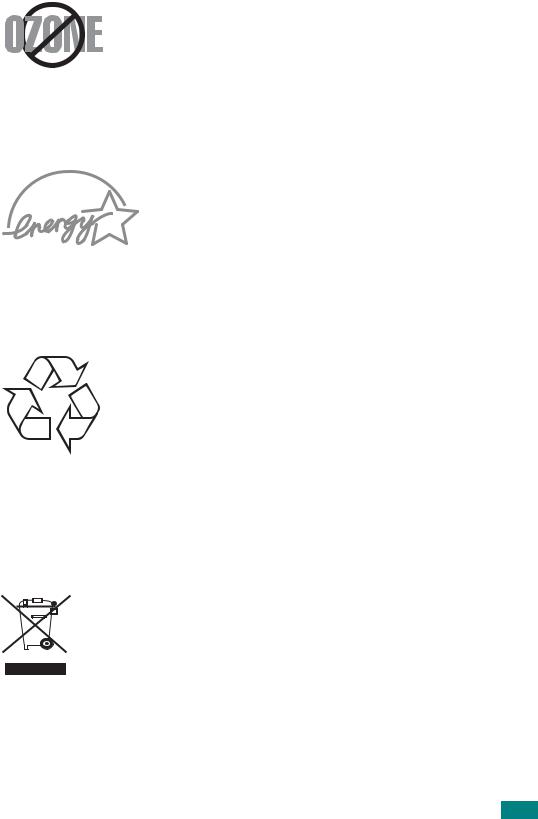
Ozone Safety
During normal operation, this machine produces ozone. The ozone produced does not present a hazard to the operator. However, it is advisable that the machine be operated in a well ventilated area.
If you need additional information about ozone, please contact your nearest Xerox dealer.
Power Saver
This printer contains advanced energy conservation technology that reduces power consumption when it is not in active use.
When the printer does not receive data for an extended period of time, power consumption is automatically lowered.
The energy star emblem does not represent EPA endorsement of any product or service.
Recycling
Please recycle or dispose of the packaging material for this product in an environmentally responsible manner.
Correct Disposal of This Product (Waste Electrical &
Electronic Equipment)
(Applicable in the European Union and other European countries with separate collection systems)
This marking shown on the product or its literature, indicates that it should not be disposed with other household wastes at the end of its working life. To
prevent possible harm to the environment or human health from uncontrolled waste disposal, please separate this from other types of wastes and recycle it
responsibly to promote the sustainable reuse of material resources.
Household users should contact either the retailer where they purchased this product, or their local government office, for details of where and how they can
take this item for environmentally safe recycling.
Business users should contact their supplier and check the terms and conditions of the purchase contract. This product should not be mixed with other commercial wastes for disposal.
7

Radio Frequency Emissions
FCC regulations
This device complies with Part 15 of the FCC Rules. Operation is subject to the following two conditions:
•This device may not cause harmful interference, and
•This device must accept any interference received, including interference that may cause undesired operation.
This device has been tested and found to comply with the limits for a Class B digital device, pursuant to Part 15 of the FCC rules. These limits are designed to provide reasonable protection against harmful interference in a residential installation. This equipment generates, uses and can radiate radio frequency energy and, if not installed and used in accordance with the instructions, may cause harmful interference to radio communications. However, there is no guarantee that interference will not occur in a particular installation. If this equipment does cause harmful interference to radio or television reception, which can be determined by turning the equipment off and on, the user is encouraged to try to correct the interference by one or more of the following measures:
1Reposition the receiving antenna.
2Increase the separation between the equipment and receiver.
3Connect the equipment into an outlet on a circuit different from that to which the receiver is connected.
4Consult the dealer or an experienced radio/TV technician for help.
CAUTION: Changes or modifications not expressly approved by the manufacturer responsible for compliance could void the user’s authority to operate the equipment.
Canadian Radio Interference Regulations
This digital apparatus does not exceed the Class B limits for radio noise emissions from digital apparatus as set out in the interference-causing equipment standard entitled “Digital Apparatus”, ICES-003 of the Industry and Science Canada.
Cet appareil numérique respecte les limites de bruits radioélectriques applicables aux appareils numériques de Classe B prescrites dans la norme sur le matériel brouilleur: “Appareils Numériques”, ICES-003 éditée par l’Industrie et Sciences Canada.
8
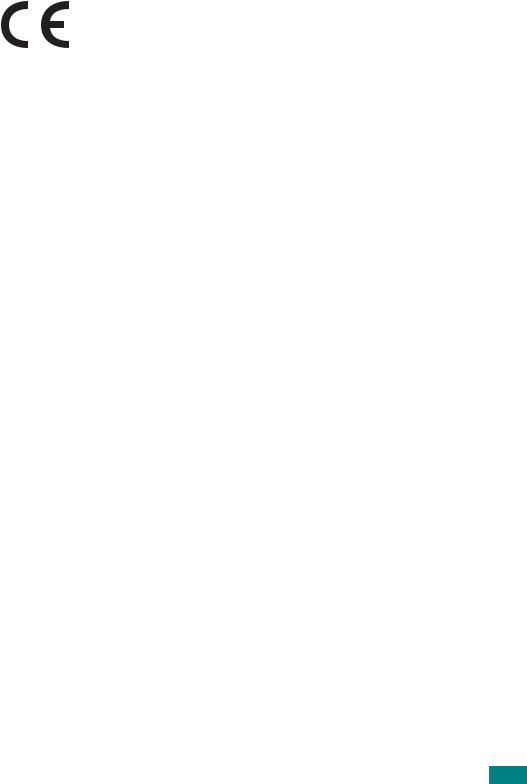
Declaration of Conformity (European Countries)
Approvals and Certifications
The CE marking applied to this product symbolizes Xerox Corporation. Declaration of Conformity with the following applicable 93/68/EEC Directives of the European Union as of the dates indicated:
January 1, 1995: Council Directive 73/23/EEC Approximation of the laws of the member states related to low voltage equipment.
January 1, 1996: Council Directive 89/336/EEC (92/31/EEC), approximation of the laws of the Member States related to electromagnetic compatibility.
March 9, 1999: Council Directive 1999/5/EC on radio equipment and telecommunications terminal equipment and the mutual recognition of their conformity.
A full declaration, defining the relevant Directives and referenced standards can be obtained from your Xerox Corporation. representative.
9

10

1 Introduction
Congratulations on the purchase of your Printer!
This chapter includes:
•Special Features
•Printer Driver Features
•Printer Components
•Understanding the Control Panel
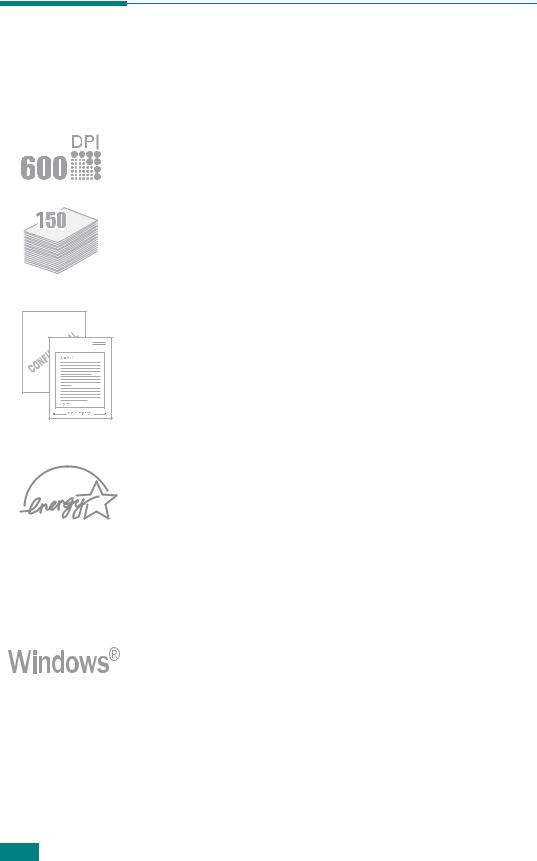
Special Features
Your new printer is equipped with special features that improve the print quality, giving you a competitive edge. You can:
Print with excellent quality and high speed
•You can print at 600 dots per inch (dpi).
•Up to 16 ppm in A4 (17 ppm in Letter).
Handle paper flexibly
•Standard 150-sheet tray supports various sizes and types of paper.
•50-sheet output tray supports convenient access.
Create professional documents
•You can customize your documents using Watermarks, such as “Confidential.” For details, See Software User Guide.
•Print Posters. The text and pictures of each page of your document are magnified and printed across the selected sheet of paper. After the document has printed, trim off the white edges of each sheet. Tape the sheets together to form a poster. For details, see Software User Guide.
Save your time and money
•Allows you to use the Toner Save mode to save toner. For details, see Software User Guide and page 4.5.
•Allows you to print multiple pages on one single sheet of paper to save paper (N-Up printing). For details, see Software User Guide.
•You can use preprinted forms and letterhead on plain paper. For details, see Software User Guide.
•This printer meets Energy Star guidelines for energy efficiency.
Print in various environments
•You can print in Windows 98/Me/2000/XP.
•Your printer is compatible with various Linux OS.
•Your printer comes with the USB interface.
1.2 INTRODUCTION

Printer Driver Features
Your printer drivers will support the following standard |
1 |
features: |
•Paper source selection
•Paper size, orientation and media type
•number of copies
Table below lists a general overview of features supported by your printer drivers.
|
Printer Driver |
|
Feature |
|
|
Win 98/Me/ |
Linux |
|
|
2000/XP |
|
|
|
|
|
|
|
Toner Save |
Y |
Y |
|
|
|
Print quality option |
Y |
Y |
|
|
|
Poster printing |
Y |
N |
|
|
|
Multiple pages per sheet (N-up) |
Y |
Y(2,4) |
|
|
|
Fit to page printing |
Y |
Y |
|
|
|
Scale printing |
Y |
Y |
|
|
|
Watermark |
Y |
N |
|
|
|
Overlay |
Y |
N |
|
|
|
INTRODUCTION 1.3
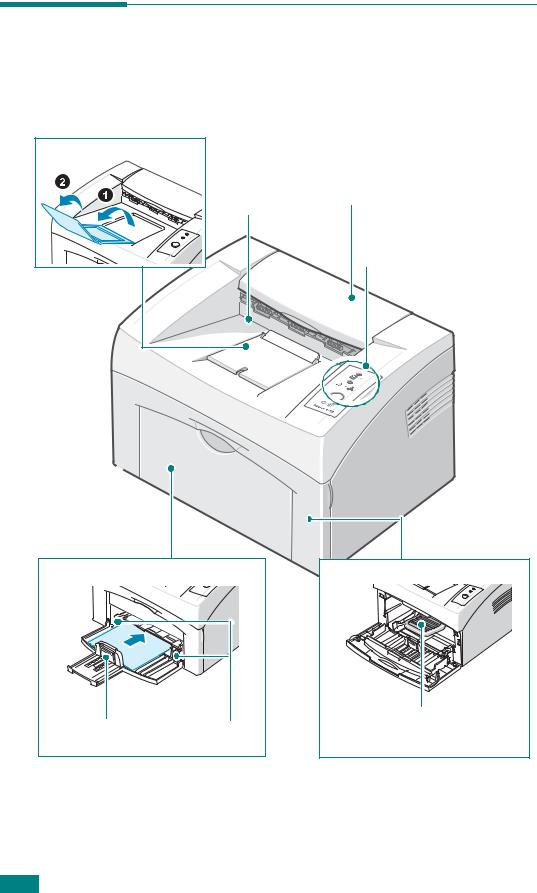
Printer Components
Front View
Output support |
Paper output tray |
(Face down) |
Top cover
Control panel
Paper input tray |
|
Rear guide |
Side guides |
Front cover |
Toner cartridge |
1.4 INTRODUCTION
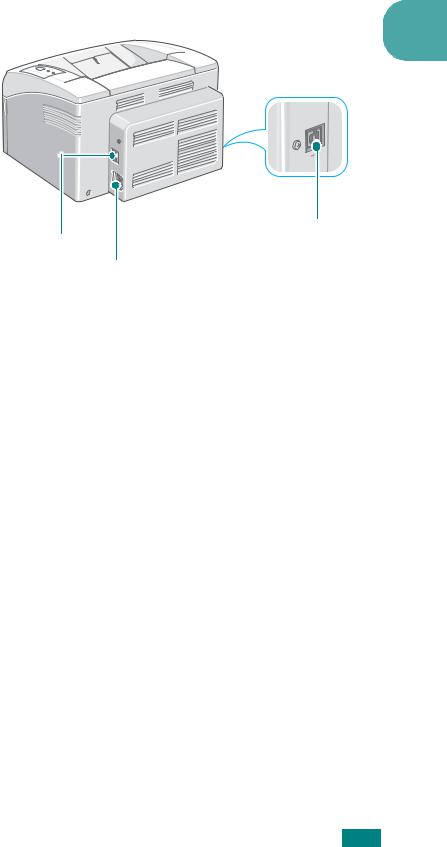
Rear View
1
USB port
Power switch
Power receptacle
INTRODUCTION 1.5
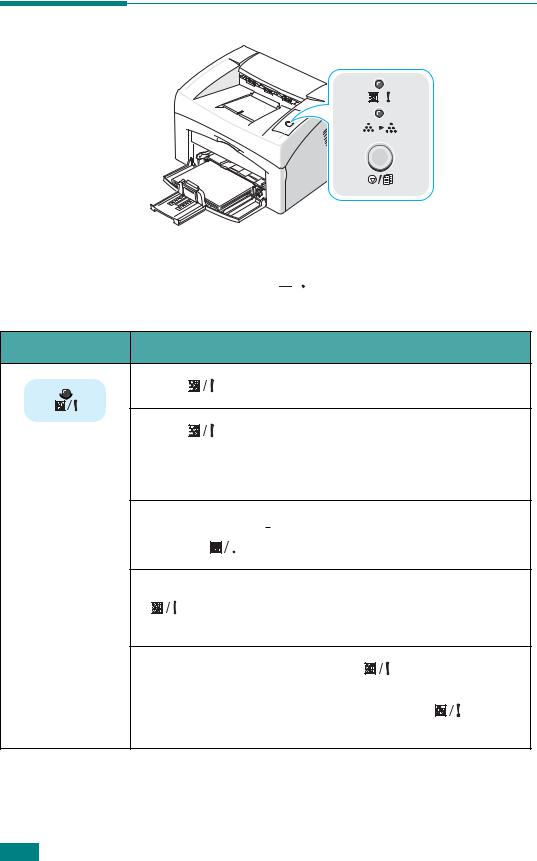
Understanding the Control Panel
On Line/Error( 


 ) and Toner Save(
) and Toner Save( 






 )
)
LEDs
LED |
Description |
If the |
lights green, the printer is ready to print. |
If the |
lights red, the printer is experiencing an error, |
such as jammed paper, no paper, the open top or front cover, |
|
or the empty toner cartridge. |
|
See “Troubleshooting Error Messages” on page 5.17. |
|
If you press the 

 button while the printer is receiving data, the
button while the printer is receiving data, the 

 LED blinks red to cancel printing.
LED blinks red to cancel printing.
In Manual Feed mode, if there is no paper in the tray, the
LED blinks green. Load paper into the tray and the LED
stops blinking.
If the printer is receiving data, the |
LED slowly blinks |
|
green. |
|
|
If the printer is printing the received data, the |
LED |
|
blinks green fast. |
|
|
1.6 INTRODUCTION
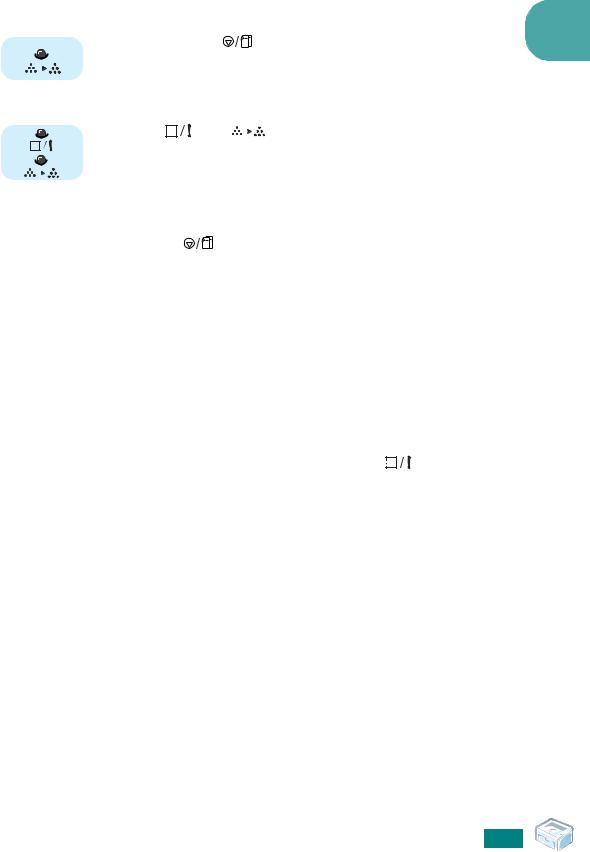
LED |
|
|
|
|
|
|
|
|
|
|
|
Description |
|
|
1 |
|||
|
|
|
|
|
|
|
|
|
|
|
|
|
|
|
||||
|
|
|
If you press the |
|
|
|
button in Ready mode, this LED is on |
|||||||||||
|
|
|
and the Toner Save mode is enabled. |
|
|
|
|
|||||||||||
|
|
|
If you press this button once again, this LED is off and the |
|
|
|||||||||||||
|
|
|
Toner Save mode is disabled. |
|
|
|
|
|||||||||||
|
|
|
|
|
|
|
|
|
|
|
|
|
|
|
|
|
|
|
|
|
|
If the |
|
|
and |
|
|
LEDs blink, your system has some |
|
|
|||||||
|
|
|
|
|
|
|
|
|||||||||||
|
|
|
problems. |
|
|
|
|
|
|
|
|
|
|
|
|
|||
|
|
|
|
|
|
|
|
|
|
|
|
|
|
|
||||
|
|
|
|
|
|
|
|
|
|
|
|
|
|
|
||||
|
|
|
To solve the problem, see “Troubleshooting Error Messages” |
|
|
|||||||||||||
|
|
|
on page 5.17 |
|
|
|
|
|
|
|
|
|
|
|
|
|||
|
|
|
|
|
|
|
|
|
|
|
|
|
|
|
|
|
|
|
|
|
|
Cancel( |
|
|
|
) button |
|
|
|
|
|||||||
|
|
|
|
|
|
|
|
|
|
|
|
|
|
|
|
|||
Function |
|
|
|
|
|
|
|
|
|
|
Description |
|
|
|
|
|||
|
|
|
|
|
||||||||||||||
Printing demo page |
In Ready mode, press and hold this button for about 2 |
|
|
|||||||||||||||
|
|
|
|
seconds until all LEDs blink slowly, and release. |
|
|
||||||||||||
|
|
|
|
|
||||||||||||||
Manual feeding |
Press this button each time you load a sheet of paper in the |
|
|
|||||||||||||||
|
|
|
|
tray, when you select Manual Feed for Source from your |
|
|
||||||||||||
|
|
|
|
software application. |
|
|
|
|
||||||||||
|
|
|
|
For detailed information, see “Using Manual Feed Mode” on |
|
|
||||||||||||
|
|
|
|
page 3.7. |
|
|
|
|
|
|
|
|||||||
|
|
|
|
|
|
|
|
|
|
|
|
|
|
|
|
|||
Canceling print job |
Press this button during printing. The |
|
LED blinks |
|
|
|||||||||||||
|
|
|
||||||||||||||||
|
|
|
|
|
|
|
||||||||||||
|
|
|
|
while the print job is cleared from both the printer and the |
|
|
||||||||||||
|
|
|
|
computer, and then return to Ready mode. This may take |
|
|
||||||||||||
|
|
|
|
some time depending on the size of the print job. |
|
|
||||||||||||
|
|
|
|
In Manual Feed mode, you can’t cancel the print job by |
|
|
||||||||||||
|
|
|
|
pressing this button. |
|
|
|
|
||||||||||
|
|
|
|
For detailed information, see “Using Manual Feed Mode” on |
|
|
||||||||||||
|
|
|
|
page 3.7. |
|
|
|
|
|
|
|
|||||||
|
|
|
|
|
||||||||||||||
Toner Save mode |
In Ready mode, press this button to turn the Toner Save |
|
|
|||||||||||||||
on/off |
mode on or off. |
|
|
|
|
|
|
|
||||||||||
|
|
|
|
For detailed information, see Software User Guide and |
|
|
||||||||||||
|
|
|
|
page 4.5. |
|
|
|
|
|
|
|
|||||||
|
|
|
|
|
|
|
|
|
|
|
|
|
|
|
|
|
|
|
INTRODUCTION 1.7

2 Setting Up Your Printer
This chapter provides step by step information on setting up your printer.
This chapter includes:
•Unpacking
•Installing the Toner Cartridge
•Loading Paper
•Connecting a Printer Cable
•Turning the Printer on
•Printing a Demo Page
•Installing Printer Software
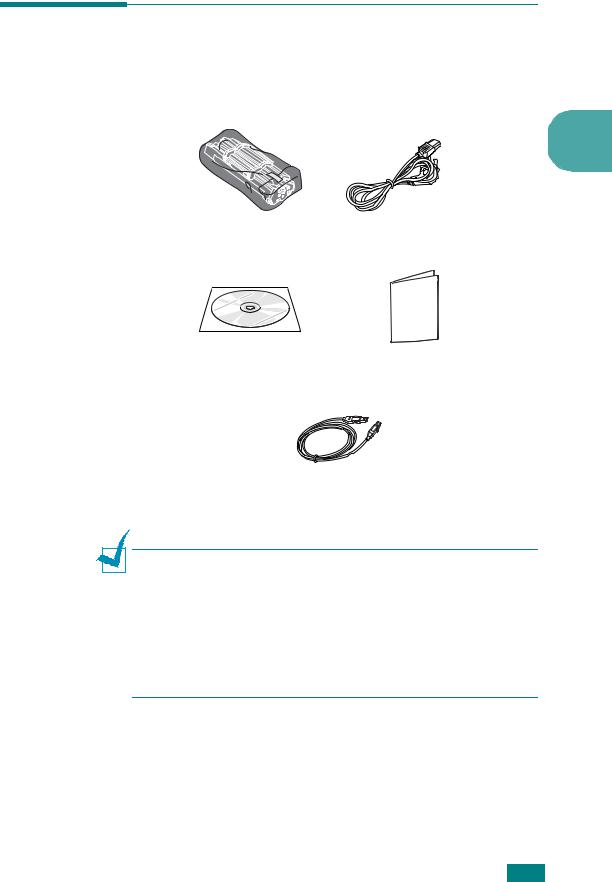
Unpacking
1Remove the printer and all accessories from the packing carton. Make sure that the printer has been packed with the following items:
2
Toner Cartridge |
Power Cord |
CD-ROM |
Quick Install Guide |
|
USB Cable
Notes:
•If any items are missing or damaged, notify your dealer immediately.
•Components may differ from one country to another.
•The appearance of the power cord is differ depending on the country.
•The CD-ROM contains the printer driver, the User’s Guide, and the Adobe Acrobat Reader program.
SETTING UP YOUR PRINTER 2.2
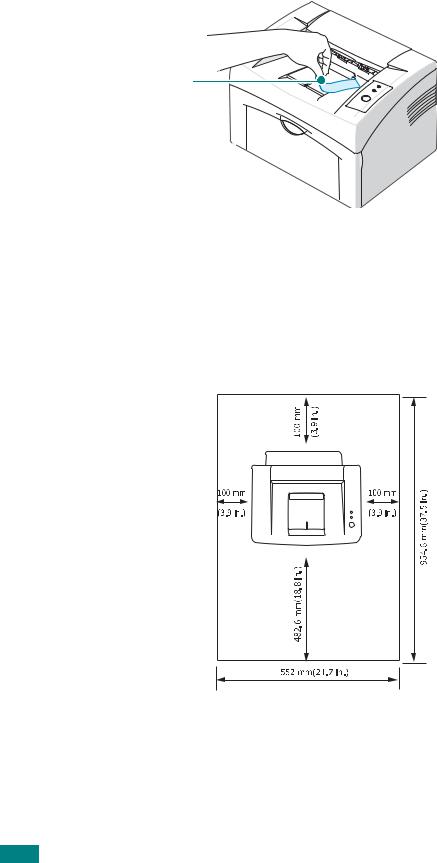
2 Carefully remove all of packing tape from the printer.
Tape
Selecting a Location
Select a level, stable place with adequate space for air circulation. Allow extra space for opening cover and tray. The area should be well-ventilated and away from direct sunlight or sources of heat, cold, and humidity. See the image below for clearance space. Do not place the printer close to the edge of your desk or table!
Clearance Space
•Front: 482.6 mm (enough space to allow opening of the paper input tray)
•Back: 100 mm (enough space for ventilation)
•Right: 100 mm (enough space for ventilation)
•Left: 100 mm (enough space for ventilation)
2.3 SETTING UP YOUR PRINTER
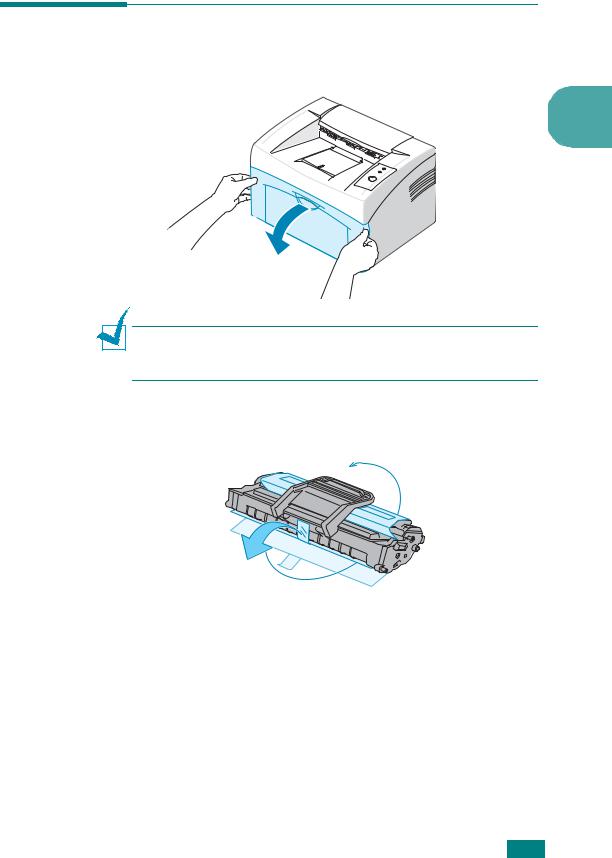
Installing the Toner Cartridge
1 Grasp the front cover and pull it toward you to open.
2
Note: Because the printer is very light, it may be moved when you use it; for example, when opening/closing the tray or installing/ removing the toner cartridge. Be careful not to move the printer.
2Remove the toner cartridge from its bag and remove the paper protecting the cartridge by pulling the packing tape.
SETTING UP YOUR PRINTER 2.4
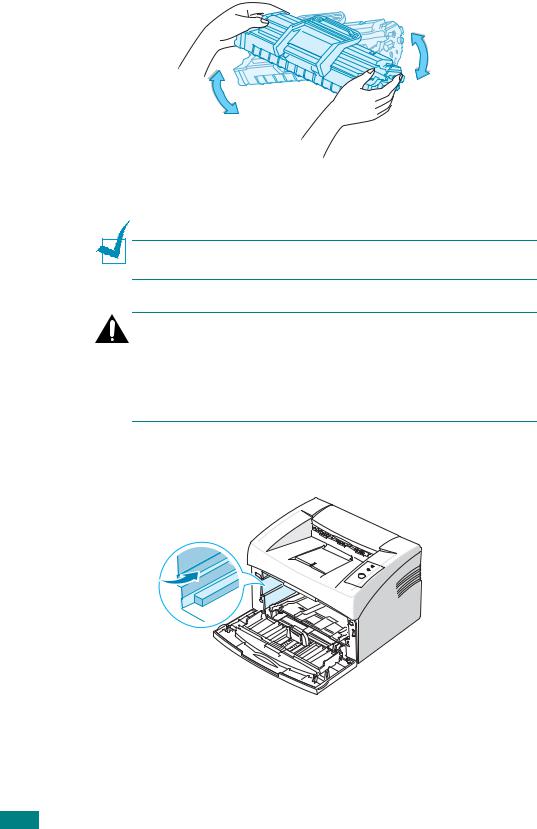
3 Gently roll the cartridge 5 or 6 times to distribute the toner.
Thoroughly rolling the cartridge will assure maximum copies per cartridge.
Note: If toner gets on your clothing, wipe it off with a dry cloth and wash clothing in cold water. Hot water sets toner into fabric.
Cautions:
• To prevent damage, do not expose the toner cartridge to light for more than few minutes. Cover it with a piece of paper, if left exposed for more than a few minutes.
•Do not touch the green underside of the toner cartridge. Use the handle on the cartridge to avoid touching this area.
4Locate the cartridge slots inside the printer, one on each side.
2.5 SETTING UP YOUR PRINTER

5Unfold the toner cartridge handle and grasp it. Insert the cartridge in the printer until it snaps into place.
2
Note: Carefully insert or pull out the toner cartridge not to scratch against the printer.
6Close the front cover. Make sure that the cover is securely closed. If the cover is not firmly closed, printing errors may occur when you print.
Note: When printing text at 5% coverage, you can expect a toner cartridge life of approximately 3,000 pages (1,000 pages for the toner cartridge that is shipped with the printer).
SETTING UP YOUR PRINTER 2.6

Loading Paper
You can load approximately 150 sheets of paper in the tray.
1Grasp the paper input tray and pull it toward you to open. Pinch the rear guide and pull it out to extend the tray.
Note: Because the printer is very light, it may be moved when you use it; for example, when opening/closing the tray or installing/ removing the toner cartridge. Be careful not to move the printer.
2Prepare a stack of paper for loading by flexing or fanning them back and forth. Straighten the edges on a level surface.
2.7 SETTING UP YOUR PRINTER
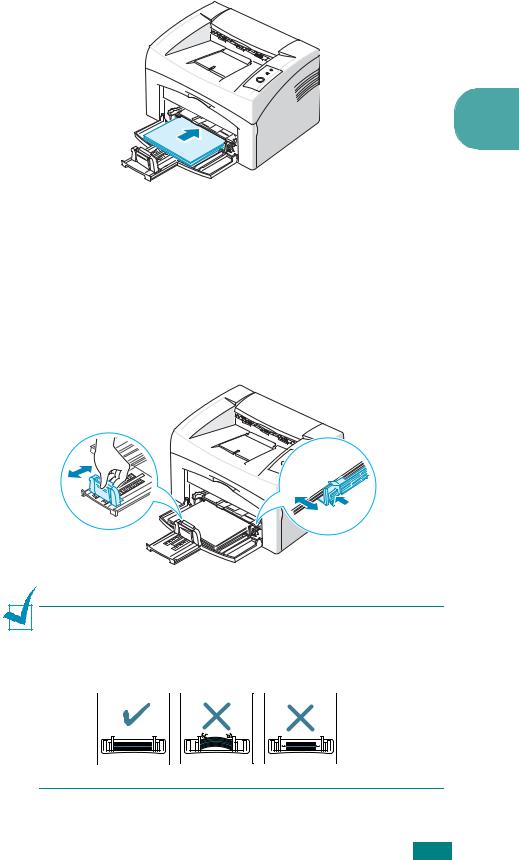
3 Load paper with the print side facing up.
2
Make sure that all four corners are flat in the tray.
4Pay attention not to overload paper. Paper overloading may cause paper jams.
5Pinch the rear guide to adjust for the paper length and pinch the side guide and slide it to the left flush against the paper.
Notes:
•Do not push the width guide far enough to cause the material to warp.
•If you do not adjust the width guide, it may cause paper jam.
SETTING UP YOUR PRINTER 2.8
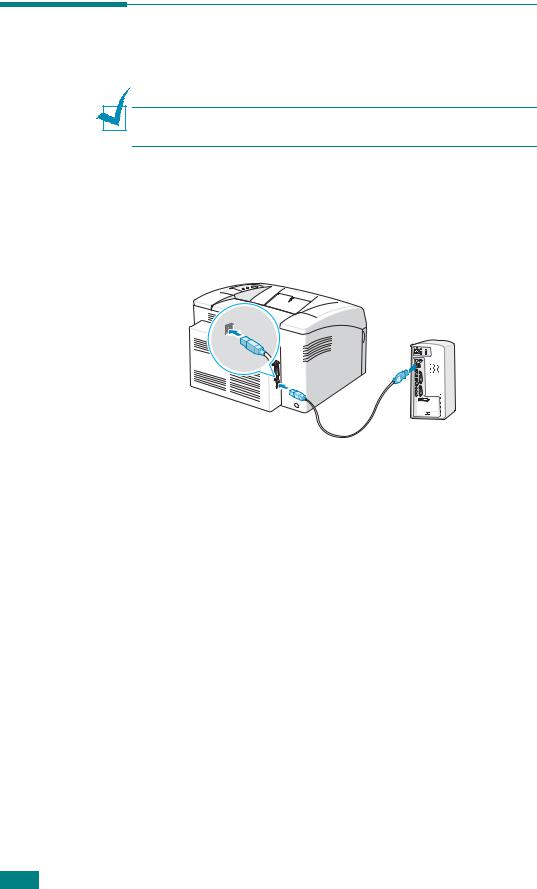
Connecting a Printer Cable
To print from your computer, you need to connect your printer to your computer with a Universal Serial Bus (USB) cable.
Note: Connecting the printer to the USB port of the computer requires a certified USB cable.
1Make sure that both the printer and the computer are turned off.
2Plug the USB printer cable into the connector on the back of the printer.
To the USB port on your computer
3Connect the other end of the cable to the USB port on your computer.
See your computer User’s Guide if you need help.
2.9 SETTING UP YOUR PRINTER
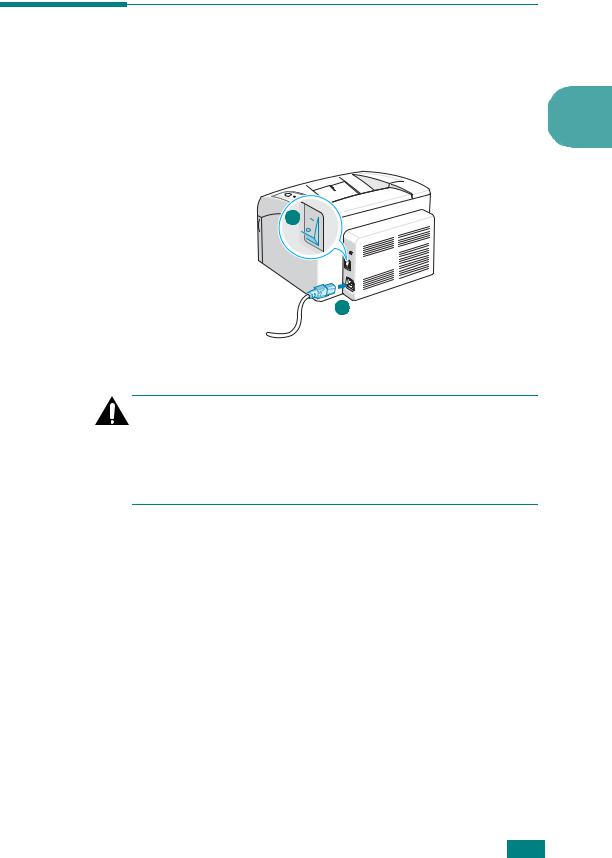
Turning the Printer on
1 |
Plug the power cord into the power receptacle on the back |
|
|
of the printer. |
2 |
2 |
Plug the other end into a properly grounded AC outlet and |
turn on the printer using the power switch.
2 


1
To the AC outlet
Cautions:
•The fusing area at the rear portion of the inside of your printer is hot when powered. Be careful not to be burned when accessing this area.
•Do not disassemble the printer when it is powered. Doing so may give you an electric shock.
SETTING UP YOUR PRINTER 2.10
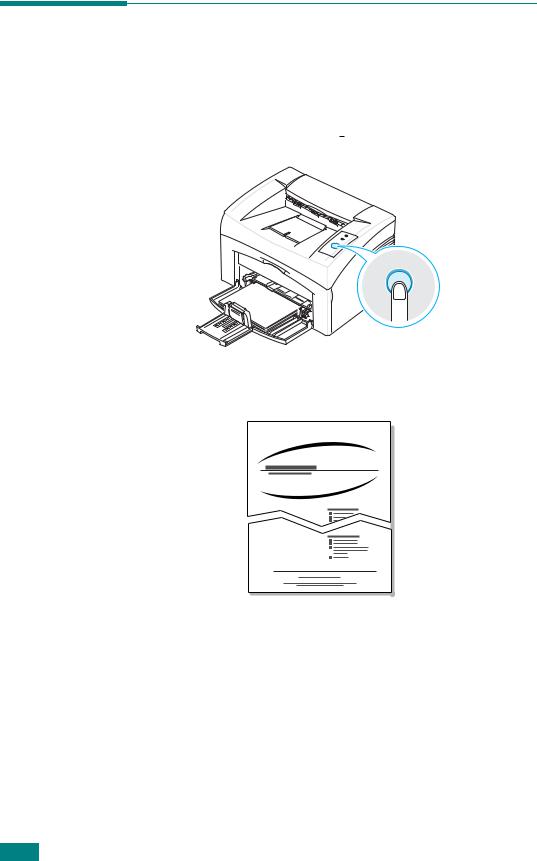
Printing a Demo Page
Print a demo page to make sure that the printer is operating correctly.
1Press and hold down the 

 button on the control panel for about 2 seconds to print a demo page.
button on the control panel for about 2 seconds to print a demo page.
2 The Demo page shows the printer’s current configuration.
2.11 SETTING UP YOUR PRINTER

Installing Printer Software
You must install software using the supplied CD-ROM after you have set up your machine and connected it to your computer. For details, see Software User Guide.
Printer driver for Windows |
2 |
Use this driver to take full advantage of your printer’s features. For details, see Software User Guide.
System Requirements
Your machine supports following operating system.
•Windows 98/Me/2000/XP - The following table shows Windows requirements.
Item |
Requirements |
||
|
|
|
|
Operating System |
Windows 98/Me/2000/XP |
|
|
|
|
|
|
|
Windows 98/Me/2000 |
|
Pentium II 400 MHz |
|
|
or higher |
|
CPU |
|
|
|
|
|
|
|
Windows XP |
|
Pentium III 933 MHz |
|
|
|
||
|
|
or higher |
|
|
|
|
|
|
|
|
|
RAM |
Windows 98/Me/2000 |
|
64 MB or higher |
|
|
|
|
Windows XP |
|
128 MB or higher |
|
|
|
||
|
|
|
|
Free Disk Space |
Windows 98/Me/2000 |
|
300 MB or higher |
|
|
|
|
Windows XP |
|
1 GB or higher |
|
|
|
||
|
|
|
|
Internet Explorer |
5.0 or higher |
|
|
|
|
|
|
NOTE: For Windows 2000/XP, the system administrator should install the software.
Printer driver for Linux
You can print in Linux using your machine.
• Various Linux - See Software User Guide.
SETTING UP YOUR PRINTER 2.12
